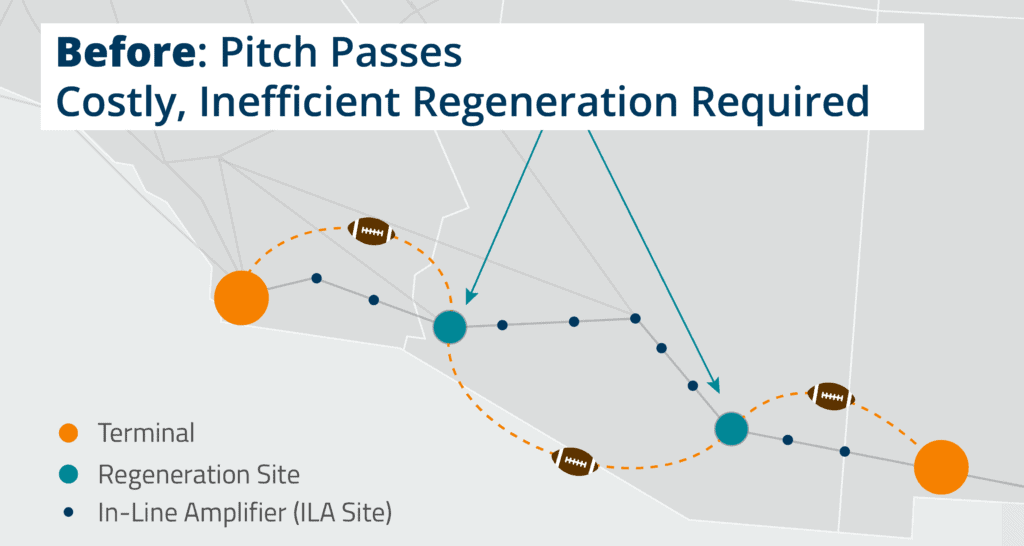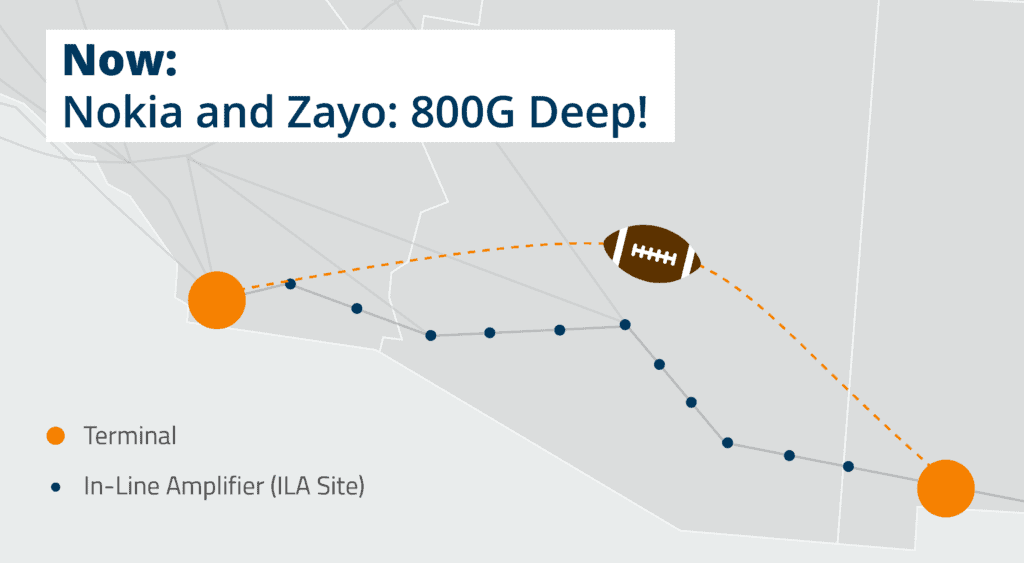
The NFL Playoffs are upon us and we love to see our team connect a deep pass for a score. Zayo and Nokia teamed up, threw the long ball, and crushed the previous 800G terrestrial distance record for a single wavelength.
We also successfully transmitted a 1Tb wavelength over 1,000km.
First, let me explain what a terrestrial optical transmission distance record for a single wavelength actually is.
Together, Zayo and Nokia transmitted a single 800 Gbps (800G) wavelength error-free for 1,866 km without regeneration, setting the record for optical transmission distance of a single wavelength at that speed without regeneration. We also transmitted 1 Tbps (1Tb) over a single wavelength – it traveled 1,004 km without regeneration, demonstrating the ability to extend the reach of high-capacity wavelengths using the industry’s newest fibre network.
The previous record, also set by Nokia, topped out at just over 1,300 km for error-free transmission of an 800G wavelength.
To understand the significance of these records and why “no regeneration” matters, let’s have a quick review of how bits and bytes actually travel long distances over fibre optic cables.
An Amplification Review
Optical fibre transmission – or wavelengths – travel down thousands of kilometers of fibre optic cable consisting of 10s or 100s of optical fibre strands each no thicker than a single hair. The signal quality degrades as it travels through the fiber. It experiences attenuation, or the reduction of optical power. In order to counteract the effect of attenuation, optical amplification must occur every 60-140 km traveled. Amplification allows the optical signal to travel further, without terminating the signal. Each time an optical signal is amplified, its power increases (this is good), but the level of noise in the signal also increases (this is bad). So, even as optical amplifiers increase the signal strength, they also dirty it, making the signal more difficult for optical receivers to ‘read.’ The increased noise is like a pass rush. The quarterback and receivers can no longer read the pass, and it falls incomplete.
As the amount of noise increases, the quality of the signal will eventually deteriorate to such an extent that Forward Error Correction (FEC) algorithms can no longer ‘clean up’ the incrementing bit errors, and uncorrected bit errors begin to appear. The goal of optical transmission is always to transmit a signal error-free, as far as possible.
A Regeneration Review
Before uncorrected bit errors appear, we must apply the more invasive and digitally complex process called regeneration. Regeneration terminates the signal, assembles it to its original format, and generates a brand new (clean) optical signal. This process increases both latency and (importantly) the cost of transmitting an optical signal. Regens are like when one play ends and teams have to scrimmage and hike the ball for the next play.
Here’s a visual representation of a signal traveling from Los Angeles to El Paso:

The record-breaking 800G and 1Tb optical transmissions by Zayo and Nokia occurred along the “express routes” of Zayo’s long haul network – the high-capacity fast lanes where traffic speeds along without interruption – without on-ramps or off-ramps. The 1Tb transmission started in Los Angeles and traveled 1,004 km to Phoenix. The record 800G transmission also started in Los Angeles and traveled 1,866 km to El Paso.
With this field trial on our production network, we successfully launched a long bomb downfield, and eliminated costly, inefficient regeneration:

How Did We Do it?
The combination of Nokia’s latest fibre optic modem (its sixth-generation Photonic Service Engine – or PSE-6s) and Zayo’s ultra-modern, ultra-clean, long-haul fibre optic network, provided the ideal environment for this successful trial.
Nokia did two things: First, they created an algorithm in their PSE-6s modem that improves the optical signal-to-noise ratio (OSNR) performance. Then, Nokia combined and optimized FEC and its new algorithm to enable the PSE-6s Digital Signal Processor (DSP) to ‘reassemble’ the complex optical signal back to its original digital format, to catch the long pass, error-free.
Zayo’s fibre network brought Nokia’s ingenuity to life. Zayo applied the benefits of the industry’s newest fibre network to extend the reach of high-capacity wavelengths with less equipment, less space, and less power per bit. We effectively pushed the signal through our fibre without the need to regenerate it, increasing the ‘spectral efficiency’ of the transmission, and created a more productive, high-performing, and cost-effective optical transmission.
The Real Benefits of Pushing the Limits of Big Bandwidth
Laying fibre isn’t easy or cheap, and we live in a highly digitized, bandwidth-hungry world. Service providers need to extract the maximum value from each fiber. With each step forward in optical modem technology, we bring more spectral efficiency (albeit less and less with each generation as Shannon’s limit nears). Just like miles per gallon, bits/ghz is also important.
With each terrestrial distance record set, Zayo improves upon the spectral efficiency of each fiber. We can offer higher capacity services, get more capacity out of each pair of fibers, leave fewer fibres “stranded,” and offer more competitive pricing to the bandwidth-hungry customer base.
Summarized, these new world records take us much further for buyers of big bandwidth:
- Lower cost per bit translating to lower pricing for future bandwidth
- Better performance by eliminating points of latency and points of failure
- Higher bandwidth services soon becoming commercially available
- Positive environmental impact with less equipment, less space, and less power for long-distance optical transmission
- Pushing the industry further as each new optical transmission record sets the stage for future enhancements of optical fibre transport
Even if your business isn’t in the market for a new 800G long-haul wavelength, this terrestrial distance record offers real promise for every Internet user. When 800G blasts along the express routes in the long haul, Zayo can move your Internet traffic from one corner of the globe to another more efficiently, providing a less expensive, more stable Internet experience for everyone (no matter your last-mile circuit speed).
More bandwidth, traveling longer distances without error, at a much lower cost per bit.
What’s Next…
Every step presents massive progress to the networked world. And the steps are coming fast! Zayo and Nokia set the new 800G record just weeks following the previous record.
We fully expect the hockey-stick demand for bandwidth and their corresponding networking improvements to continue. Know that Zayo will take every advantage, investing in our infrastructure, and building the capacity and capability our customers depend on for their businesses to thrive.
And we look forward to continuing to partner with the best hardware manufacturers in the industry to leverage Zayo’s high performing, highly capable global network, set new records, and establish new firsts – all season long!
